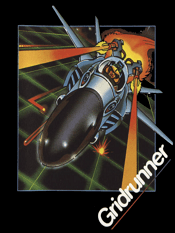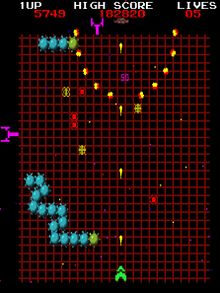Gridrunner
Gridrunner is a series of shoot 'em up games written by Jeff Minter/Llamasoft. The original Gridrunner was first published for the Commodore Vic 20 in 1982, and ported to various 8-bit computer platforms. It is the developer's longest running series, and remains one of his most enduringly popular, with eight titles released between 1982 and 2018.
| Gridrunner | |
|---|---|
 | |
| Developer(s) | Jeff Minter |
| Publisher(s) |
|
| Platform(s) | VIC-20, Atari 8-bit, Commodore 64, Amiga, ZX Spectrum, Dragon 32 |
| Release | 1982 |
| Genre(s) | Shoot 'em up |
Gameplay
The game is similar to the Atari game Centipede, with long, segmented enemies that progress in a zig-zag fashion and can be broken apart. Players control a small ship that can fire upwards and move freely around the screen. The player must also avoid pulses emitted by the X-Y zappers which patrol the edges of the grid. The game has twenty waves of enemies to complete.[1]

The player controls a small, constantly firing, ship that can be steered around the whole of the playfield with swipes of the iOS touchscreen. Various enemies appear on the playfield and will attack the player's ship. The game is divided into a number of levels (or grids) with set patterns of enemy attack on each grid. At the end of each level a bonus life is awarded and the next grid begins. To aid the player shooting certain enemies will release spinning coloured disks that increase the player's attacking powers, these power-ups are short-lived but collecting multiple disks will increase the potency and/or duration of the power-up. More enemy types are introduced as the player moves through the levels of the game, enemies also become more dangerous as the game progresses. The game can be played in Pure or Casual mode. In Pure mode the player has to start at the first level and progress through each level consecutively until all their lives are lost, after level 4 and every 4th level thereafter the game will create a save point. In Casual mode the player can resume the game at any of the save points they created when playing in Pure mode with their score and lives set to their best performance at that point. Pure and Casual modes have separate high score tables.
Development
Llamasoft released Gridrunner in 1982 for the unexpanded VIC-20. The game was written over the course of a single week, which Minter refers to as "the best week of work I've ever done."[2] Although it draws its inspiration from the arcade game Centipede[3][4] with the concept of a snake-like enemy descending the screen through a series of obstacles (mushrooms in centipede, pods in Gridrunner) it plays much faster. Versions of the game appeared for several of the home computers of the early 1980s.
Reception
Of Gridrunner, The Commodore 64 Home Companion advised "forget the plot; fast action is the name of this game".[5] Ahoy! called Attack of the Mutant Camels the product of "a fiendish mind", with "serviceable" graphics ("so if you're wondering what a mutant camel really looks like, forget it") and excellent sound effects, and concluded that it was "all in all, a fine game".[6]
Eurogamer called the iOS release "the best shooter on iOS,"[7] and Touch Arcade described it as "a retro remake done right".[8] As of March 2012, it has a Metacritic score of 83.[9]
Legacy
In 1983, Minter released Matrix: Gridrunner 2, which retained much of the original's gameplay, but introduced new enemy types and a scrolling background. It was first published on the Commodore 64, and ported to other platforms. This title was released in the US as Attack of the Mutant Camels, a title taken from an unrelated Llamasoft title released in the UK. A second sequel, Voidrunner, followed in 1987, which abandons the grid backgrounds, and features more colorful and elaborate graphics.
In 1991, Llamasoft released Super Gridrunner for the Atari ST. The first 32-bit title in the series, it added power-ups to the series for the first time, while retaining the basic elements of a single-screen shooter. This would be the last entry in the series for over a decade, during which time Jeff partnered with Atari on updates to the Tempest and Defender series.
Gridrunner was revived in 2002 with Gridrunner++, a shareware downloadable title released on Llamasoft's website. Featuring retro sprite-based visuals and faster-paced gameplay on a scrolling field, it proved popular with fans. A sequel followed in 2009. Originally developed under the working title Gridrunner+++ it was released on Windows PCs as Gridrunner Revolution, after a newly introduced rotation mechanic. This version also made heavy use of Minter's "light synth" tech, with colorful, psychedelic visuals. It's also the only title in the series with a full musical soundtrack.
In 2011, Llamasoft released a reimagined version for iOS, simply titled Gridrunner. This new version tales cues from the early '80s arcade titles that first inspired the series, with retro-styled visuals and single-screen gameplay. It was later ported to Android as shareware. In 2018, Llamasoft released Minotaur Arcade Vol. 1 a two-pack that included new version of Gridrunner and GoatUp. This version is most closely based on the 2011 iOS version, but remade with 3D voxels, and heavily remixed and expanded.
References
- http://www.the-commodore-zone.com/articlelive/articles/84/6/The-Goatbuster/Page6.html
- http://b3ta.com/interview/jeffminter/
- Cowan, Danny. Jeff Minter Readies Updated Gridrunner For iOS. IndieGames. 22 February 2012.
- Cowan, Danny. Best of iOS news: From Midway Arcade to Ziggurat. Gamasutra. 28 February 2012.
- Beekman, George (1984). "Human Engineered Software (HesWare)". The Commodore 64 Home Companion. pp. 171–172. Retrieved 19 August 2016.
- Kincaid, Scott (May 1984). "Attack of the Mutant Camels". Ahoy!. p. 59. Retrieved 27 June 2014.
- Stanton, Rich (2 March 2012). "App of the Day: Gridrunner". EuroGamer.net.
- "Touch Arcade Gridrunner review".
- "MetaCritic rating for Gridrunner iOS".
External links
- Gridrunner at Lemon 64
- Gridrunner for the Atari 8-bit family at Atari Mania
- Gridrunner for the Atari ST at Atari Mania
- Gridrunner at Amiga Hall of Light